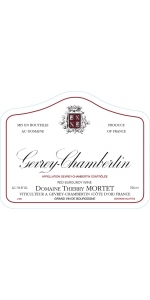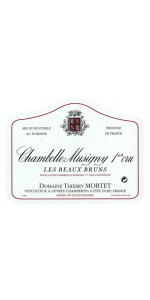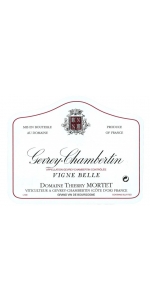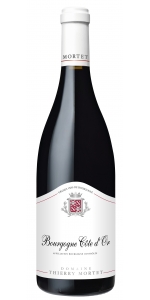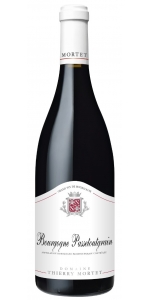Thierry Mortet Gevrey-Chambertin 2019
| Country: | France |
| Region: | Burgundy |
| Winery: | Thierry Mortet |
| Grape Type: | Pinot Noir |
| Organic: | Yes |
| Vintage: | 2019 |
| Bottle Size: | 750 ml |
Thierry Mortet Gevrey-Chambertin is made from 100 percent Pinot Noir.
The wine is produced from 20 different parcels (3 hectares total). The soils are a mix of clay and silt.
The age of wines varies between 15 to 60 years.
Yield: 45 hl/ha
Production: 15,000 bottles on average.
Manual harvest with a selection of the grapes; sorting table; 100% destemming; maceration for 15 days, cold stabilization for 4-5 days; M-L.; racking twice a day. Fermentation in stainless steel tanks for 4 months. Aging in oak barrels for 12 months (new and 1 or 2 year old barrels). Kieselguhr filtration before bottling.
Liquorice, blackberry, red fruits flavors.
Excellent with meat, game and cheeses.
Thierry Mortet Chambolle Musigny 1er Cru Beaux Bruns is made from a single vineyard. (0.55 acre). 30 years old vines, planted on clay, limestone and flint based soils.
The wine is produced from a single vineyard (0.55 acres) planted on clay, limestone and flint based soils. It shows a dark color, ripe black fruit and pepper aromas. Long and intense flavors. Smooth tannins, good length and red fruits on the finish. An elegant wine with a delicate, beautiful structure.
Very fine wine, delicate, beautiful structure.
Thierry Mortet Gevrey Chambertin Vigne Belle is made from 100 percent Pinot Noir.
The wine is produced from 20 different parcels (3 hectares total). The soils are a mix of clay and silt.
The age of wines varies between 15 to 60 years.
Yield: 45 hl/ha
Production: 15,000 bottles on average.
Manual harvest with a selection of the grapes; sorting table; 100% destemming; maceration for 15 days, cold stabilization for 4-5 days; M-L.; racking twice a day. Fermentation in stainless steel tanks for 4 months. Aging in oak barrels for 12 months (new and 1 or 2 year old barrels). Kieselguhr filtration before bottling.
The wine offers a subtle and complex nose. It displays a sweet and delicate mouthfeel. Very nice wine with black fruit aromas. Dense, good concentration. Good length and well integrated oak.
A parcel of 90 ares, one part is 20 years old and the other part is 55 years old. Its is called Les Pressonniers, in Gevrey-Chambertin.
Bourgogne Rouge Côte d’Or comes from a plot of Gevrey-Chambertin vines, giving delicate fruit and body, as well as the character and complexity of the Gevrey-Chambertin terro
Mortet Bourgogne Passetoutgrain is mae from 60% Gamay and 40% Pinot Noir
Aged 11 months in Neutral French oak barrels.
12% ABV
Malolactic fermentation in barrel.
Slight filtration before bottling.
Bourgogne Passetoutgrains is an Appellation d'origine contrôlée (AOC) for wine from the region of Burgundy.
Most Bourgogne Passetoutgrains is red, although rosé wine may also be produced. Unlike other Burgundy wines, which are
primarily produced from a single grape variety, Bourgogne Passetoutgrains is essentially a cuvée of Gamay and Pinot noir.
This is a quintessential bistro wine. Fresh and fruity, displaying red and black fruit flavors. Well balanced, good structure and silky finish with excellent length. Serve slightly chilled.
Oeufs en Meurette (poached eggs served in a red wine sauce with onions and lardons).
Boeuf Bourguignon (beef cooked in red wine with carrots and patatoes).
Pizza and pasta.
Mortet Bourgogne Cote d'Or Rouge is made from 100 percent Pinot Noir.
A parcel of 90 ares, one part is 20 years old and the other part is 55 years old. Its is called Les Pressonniers, in Gevrey-Chambertin.
Bourgogne Rouge Côte d’Or comes from a plot of Gevrey-Chambertin vines, giving delicate fruit and body, as well as the character and complexity of the Gevrey-Chambertin terro
Thierry Mortet Gevrey-Chambertin is made from 100 percent Pinot Noir.
The wine is produced from 20 different parcels (3 hectares total). The soils are a mix of clay and silt.
The age of wines varies between 15 to 60 years.
Yield: 45 hl/ha
Production: 15,000 bottles on average.
Manual harvest with a selection of the grapes; sorting table; 100% destemming; maceration for 15 days, cold stabilization for 4-5 days; M-L.; racking twice a day. Fermentation in stainless steel tanks for 4 months. Aging in oak barrels for 12 months (new and 1 or 2 year old barrels). Kieselguhr filtration before bottling.
Liquorice, blackberry, red fruits flavors.
Excellent with meat, game and cheeses.
The Domaine Thierry Mortet Estate
The Domaine was officially created in 1992, when Thierry’s father retired and his estate was divided between his two sons. Thierry studied enology and viticulture in Beaune before joining his parents and brother and working at the Domaine
Thierry uses Burgundy barrels from Rousseau et Toutan, one third new each year. Annually, the estate bottles 1,100 cases. Thierry strives for fruit and finesse in his wines. Generally his top wines age well for 10-15 years.
The Domaine Thierry Mortet Vineyard
Thierry started in 1992 with a 4 hectare vineyard. It now measure 7 hectares (17.5 acres) and produces 85% red wine and 15% white wine. The vineyards spread over four villages: Gevrey-Chambertin, Chambolle-Musigny, Couchey and Daix (west of Dijon).
Thierry Mortet uses classic winemaking techniques: pre-fermentation maceration for 3 or 4 days, total fermentation time of 2 weeks. The grapes are harvested by hand, are sorted and are 100% de-stemmed. The result is expressive, full-bodied, generous, pure wines.
Starting with the 2010 vintage, the Estate is now certified Organic !
- back
Holocene The Black Square Cabernet Sauvignon is made from 100 percent Cabernet Sauvignon.
There is something ethereal about Cabernet Sauvignon grown in the cobblestone soils of the Walla Walla Valley. This region offers aromatic exuberance, elegance, finesse, a polished texture, layered complexity, and remarkable length. It is a place where one can craft a singular, stand-alone example of this varietal—unique not only in the United States but worldwide—while still echoing some of our favorite wines from Bordeaux.
In 2022, Winemaker Todd Alexander embarked on a new (yet familiar) journey that he had been patiently awaiting the perfect moment to explore. The Black Square is in its inaugural vintage, and this 2022 is 100% Cabernet Sauvignon grown in the Rocks District of Milton-Freewater, Oregon, which is part of the Walla Walla Valley.
The Black Square embodies elegance and grace framed by great structure, supple texture, and acidity to ensure longevity. It shows ample fruit with complex savory notes. This is not a heavy wine that is monolithic and dull—there are already plenty of those available. This wine offers a unique expression of Cabernet; it may be the most delicious wine Todd Alexander has ever crafted, venturing into new territory for Rocks District Cabernet Sauvignon.
Review:
As black as squid ink, The Black Square is balance personified. A concentrated blackberry aroma seems as dark as the wine's name, with equally dark espresso, olive and charred steak notes joining it in the abyss. A dark plum and ripe boysenberry flavor combo is accompanied by traces of salty Mission olives, wet slate and silky smooth tannins. The one bright feature illuminating the way is the wine's amped-up acidity. None so black
-Wine Enthusiast 98 Points Number 5 in the Top 100
Guillemot-Michel Vire Clesse is made from 100 percent Chardonnay.
Beautifully expressive, with yellow fruits, orange blossom, smoke & flint. Thick and saline on entry, then seriously deep in the mid-palate, with suggestions of exotic fruits perfectly countered by strong minerality. This wine strikes a perfect balance between sweet and salty elements, and it shows vibrant acidity. It boasts a thickness that few other northern Mâconnais can match.
Enjoy with fish (such as sole meuniere), seafood, roasted chicken, goat cheese.



